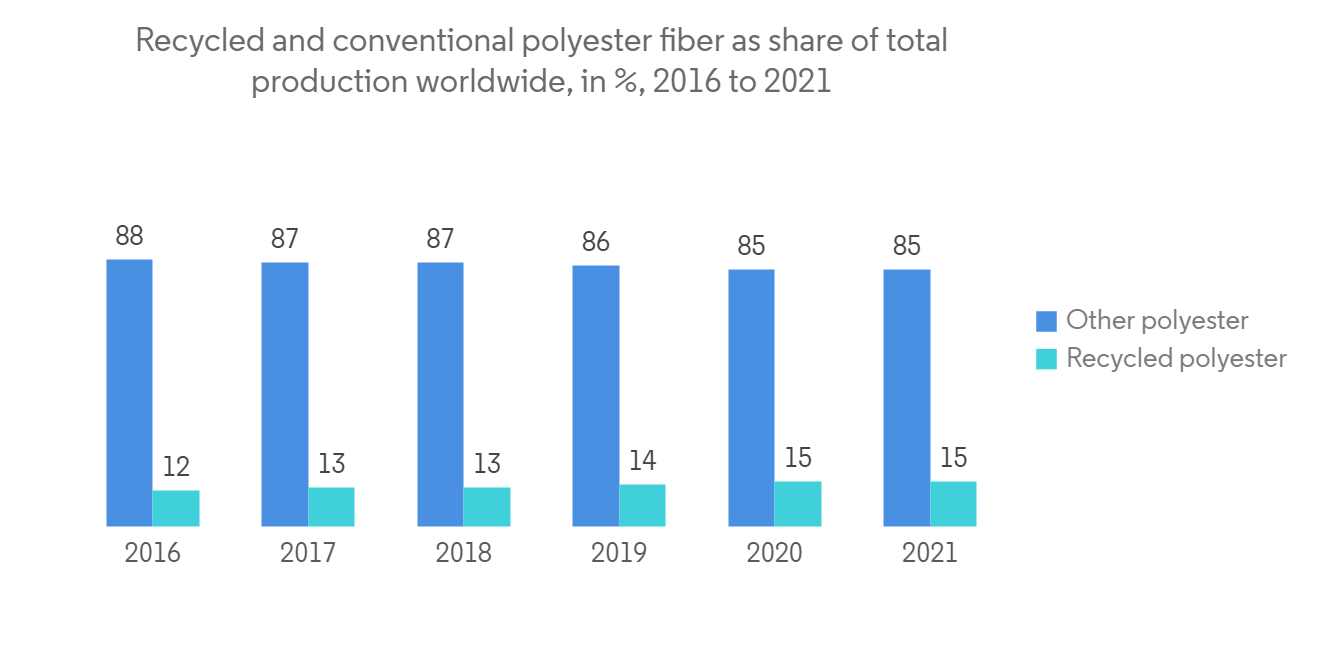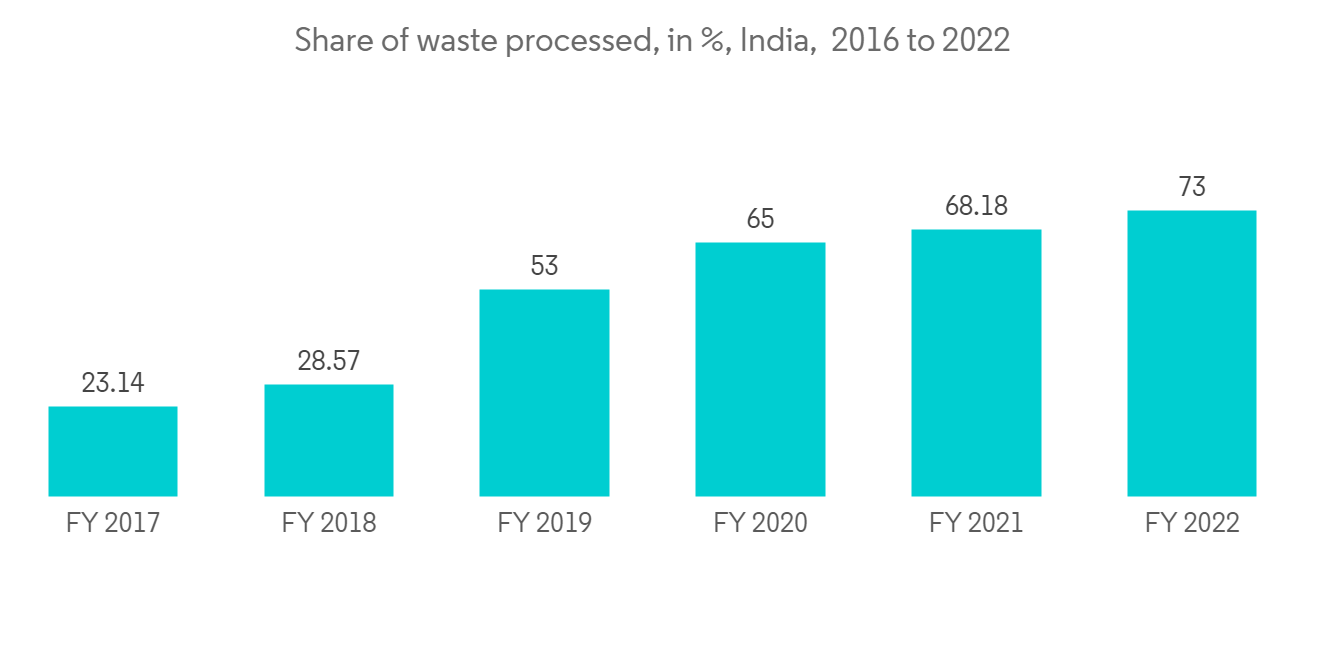 |
市場調查報告書
商品編碼
1258786
紡織廢物管理市場 - COVID-19 的增長、趨勢、影響和預測 (2023-2028)Textile Waste Management Market - Growth, Trends, and Forecasts (2023 - 2028) |
||||||
※ 本網頁內容可能與最新版本有所差異。詳細情況請與我們聯繫。
預計在預測期內,紡織廢料管理市場的複合年增長率將超過 3%
主要亮點
- 由於人們的回收意識和對環境的關注度不斷提高,預計紡織品回收市場將會增長。 此外,COVID-19 大流行對全球市場的增長產生了負面影響。 由於實施預回收流程的限制和障礙,紡織品回收行業面臨挫折。
- 因此,服裝和紡織品堆積在倉庫中,減緩了市場發展。 在美國,各種舉措和初創企業越來越受歡迎,並為提高紡織品回收率做出了重大貢獻。 ATRS(American Textile Recycling Services)是一家捐贈箱運營商,提供服裝、鞋類和家居用品的捐贈和收集服務。 ATRS 是一家提供服裝、鞋類和家居用品捐贈和收集服務的捐贈箱運營商,它正在向美國各地的新地點擴張,以加速擴大回收範圍。
- 此外,回收程序的進步和行業的新研究也有望幫助擴大市場。 例如,在 2022 年 2 月舉行的國際纖維素纖維會議上,LIST Technology AG 宣布了一款全回收萊賽爾 T 卹,作為紡織品回收業務向前邁出的重要一步。 有限的可用性和足夠的可回收材料的使用嚴重限制了市場擴張。 在大多數情況下,織物材料是組合在一起的,這使得分類過程和後續回收變得困難。 在新興國家,非正規供應商也在收集和分類,這正在影響整體回收率和市場擴張。
紡織廢料管理市場趨勢
聚酯再生產業有望快速增長
由於時尚行業的需求增加,聚酯回收正在加快速度。 公司致力於在他們的服裝中使用更多的再生聚酯來代替普通聚酯。 大多數聚□胺回收利用尼龍,並且大部分回收是通過化學回收方法完成的。 回收尼龍存在很多技術難點,目前回收尼龍的企業寥寥無幾。 大多數用於回收的聚□胺來自消費後紡織品,但它們也可能來自已經使用過的漁網等物品。
2022 年 12 月,美國國家可再生能源實驗室 (NREL) 的科學家發現了一種□,可以使回收廢舊聚酯織物和瓶子比從石油中生產它們更便宜。. NREL 研究人員提出了多種□,可以分解各種聚對苯二甲酸乙二醇酯 (PET),甚至是持久的結晶形式。
一旦去除聚酯廢料,回收的 PET 就可以製成滌綸紗線。 由於這種紗線具有與原生滌綸相同的特性,因此製造新紗線所需的能源更少。 回收聚酯廢料不僅可以降低能源消耗,消除塑料廢料在環境中的擴散,還可以降低後續製造成本,創造出高質量的產品。

亞太地區主導全球紡織廢物管理行業
印度政府即將推出的新項目和建立綜合紡織園區的計劃推動了區域市場增長。 此外,越來越多的紡織品出口到美國、歐洲等國家,而中國、印度、孟加拉國和越南是重要的紡織國家,增加了市場拓展的潛力。 紡織廢物管理也由廢水處理廠主導,並將在未來四年內繼續如此。 解決全球水資源短缺和清潔水供應中斷的環境挑戰的需要正在推動該行業的發展。
隨著由回收織物和塑料等有機材料製成的生態服裝的出現,亞太市場也在蓬勃發展。 其他增長因素包括上門收集衣物的流行以及在公共場所安裝衣物收集箱。 此外,越來越多的人因為舒適等優點而選擇家居材料,這也促進了市場的增長。 此外,亞太地區的紡織品回收市場預計在未來幾年將增長,主要參與者將開髮用於自動分揀應用的新技術。

紡織廢料管理行業概覽
最終用戶的需求在行業中創造了激烈的競爭,導致行業碎片化。 Infinite Fiber Company (IFC) 大力投資紡織品回收。 該公司近期在H&M Group、RGE Pte Ltd、Virala和新加坡Fortum等知名製造商的支持下,一直在開發回收技術。
全球紡織廢料管理行業有望投資於創新技術。 此外,這些供應商的成功在很大程度上取決於他們是否願意接受原料生產。 Worn Again Technologies、Re:NewCell 和 Pistoni S.r.l. 是該行業的主要參與者。
其他福利:
- Excel 格式的市場預測 (ME) 表
- 3 個月的分析師支持
內容
第一章介紹
- 調查結果
- 調查先決條件
- 調查範圍
第二章研究方法論
第 3 章執行摘要
第 4 章市場洞察和動態
- 市場概覽
- 市場驅動力
- 市場製約因素/挑戰
- 市場機會
- 價值鏈/供應鏈分析
- 波特的五力分析
- 新進入者的威脅
- 買家/消費者的議價能力
- 供應商的議價能力
- 替代品的威脅
- 競爭對手之間的競爭強度
- 行業創新
- 政府為吸引行業投資所做的努力
- 關於 COVID-19 對行業的影響
第 5 章市場細分
- 通過浪費
- 危險
- 塑料
- 滌綸
- 其他廢物
- 按服務
- 公開傾銷
- 焚燒
- 垃圾填埋場
- 回收
- 最終用戶
- 住宅
- 商業
- 工業
- 其他最終用戶
- 按地區
- 北美
- 美國
- 加拿大
- 墨西哥
- 歐洲
- 德國
- 法國
- 英國
- 意大利
- 西班牙
- 俄羅斯
- 其他歐洲
- 亞太地區
- 中國
- 日本
- 印度
- 孟加拉國
- 土耳其人
- 韓國
- 澳大利亞
- 印度尼西亞
- 其他亞太地區
- 中東和非洲
- 埃及
- 南非
- 沙特阿拉伯
- 其他中東和非洲地區
- 南美洲
- 巴西
- 阿根廷
- 其他南美洲
- 北美
第6章競爭格局
- 市場集中度概述
- 公司簡介
- Worn Again Technologies
- Veolia Environnement S.A.
- Boer Group
- Re:NewCell
- Pistoni S.r.l
- Lenzing AG
- Textile Recycling International
- RE TEXTIL Deutschland GmbH
- Hyosung Group
- Infinited Fiber Company
第7章市場機會與未來趨勢
第8章附錄
- 按活動劃分的 GDP 分佈
- 對資本流動的見解
The Textile Waste Management Market is expected to register a CAGR of over 3% during the forecast period.
Key Highlights
- The textile recycling market is expected to grow because people are becoming more aware of recycling and because they care more about the environment.Furthermore, the COVID-19 pandemic had a detrimental influence on worldwide market growth. The textile recycling industry is facing a setback due to constraints and impediments to executing the pre-recycling process.
- As a result, garments and textiles are stacked up in warehouses, slowing market development. Various initiatives and start-ups are gaining traction in the United States, contributing considerably to the rising rate of textile recycling. ATRS (American Textile Recycling Services) is the donation bin operator for clothes, footwear, and household items donation and collection services. ARTS is constantly extending to new locations around the country, accelerating the expansion of recycling.
- Furthermore, advancements in recycling procedures and new research in the industry are expected to aid market expansion. For example, at the International Conference on Cellulose Fibers in February 2022, LIST Technology AG presented an all-recycled lyocell t-shirt as a major step forward in the textile recycling business. The restricted availability and accessibility of sufficient recyclable material severely limits market expansion. Most of the time, the fabric material is combined, making the sorting procedure and subsequent recycling difficult. Additionally, informal vendors carry out the collecting and sorting process in less developed countries, which has an impact on the overall recycling rate and market expansion.
Textile Waste Management Market Trends
The Polyester Recycling Industry Is Predicted To Grow At A Rapid Pace
Polyester recycling is picking up speed because there is more demand for it in the fashion industry. Companies have promised to use more recycled polyester in clothes by replacing regular polyester.The majority of polyamide recycling is done using nylon, and the majority of the recycling is done using the chemical recycling method. The nylon recycling process is filled with technological difficulties, and there are now just a few businesses that recycle nylon. Polyamide used for recycling comes mostly from used fabric, but it can also come from things like fishing nets that have already been used.
And in December 2022, scientists at the National Renewable Energy Laboratory (NREL) in the United States found enzymes that might make recycling waste polyester fabrics and bottles cheaper than producing them from petroleum. Researchers at NREL came up with different enzymes that can break down all types of polyethylene terephthalate (PET), even the kind that lasts a long time and is crystalline.
When polyester waste is taken away, it is possible to make polyester yarn from recycled PET. This yarn has the same properties as first-process polyester, so it uses less energy to make new things. Polyester trash recycling not only reduces energy consumption and eliminates plastic waste dispersion in the environment, but it also saves money on subsequent manufacturing and high-quality goods.

Asia Pacific Region Dominated The Global Textile Waste Management Industry
Regional market growth is helped by upcoming new projects and plans by the Indian government to set up integrated textile parks. Also, more textiles are being sent to places like the U.S. and Europe, and the fact that China, India, Bangladesh, and Vietnam are important textile countries makes the market more likely to grow. Also, wastewater treatment plants dominated a part of the market for managing textile waste, and they are likely to continue to do so over the next four years. The need to address environmental concerns about water shortages and the loss of clean water supplies around the world is what is driving the growth of this industry.
The Asia-Pacific market is also getting a boost from the creation of eco-clothes made from recycled fabrics, plastics, and other organic raw materials. Aside from that, the popularity of door-to-door clothing pickup and the installation of clothing collection bins in public places are key growth drivers. And the market is growing because more people are choosing house materials because they are comfortable and have other benefits. Moreover, the Asia-Pacific textile recycling market is expected to grow over the next few years as leading companies create new technologies for automated sorting applications.

Textile Waste Management Industry Overview
The market is broken up because recycled textiles are being used in more and more consumer sectors to help make other products.End-user demand has created strong competition in the industry, resulting in industrial fragmentation. The Infinited Fiber Company (IFC) has invested much in textile recycling. The firm recently gained backing from well-known manufacturers to develop its recycling technology, including H&M Group, RGE Pte Ltd., Virala, and Singapore-based Fortum.
The global textile waste management industry is projected to invest in innovative technologies. Furthermore, the success of these suppliers is heavily reliant on their willingness to accept raw production. Worn Again Technologies, Re:NewCell, and Pistoni S.r.l. are a few of the industry's significant players.
Additional Benefits:
- The market estimate (ME) sheet in Excel format
- 3 months of analyst support
TABLE OF CONTENTS
1 INTRODUCTION
- 1.1 Study Deliverables
- 1.2 Study Assumptions
- 1.3 Scope of the Study
2 RESEARCH METHODOLOGY
3 EXECUTIVE SUMMARY
4 MARKET INSIGHTS AND DYNAMICS
- 4.1 Market Overview
- 4.2 Market Drivers
- 4.3 Market Restraints/Challenges
- 4.4 Market Opportunities
- 4.5 Value Chain/Supply Chain Analysis
- 4.6 Porter's Five Forces Analysis
- 4.6.1 Threat of New Entrants
- 4.6.2 Bargaining Power of Buyers/Consumers
- 4.6.3 Bargaining Power of Suppliers
- 4.6.4 Threat of Substitute Products
- 4.6.5 Intensity of Competitive Rivalry
- 4.7 Technological Innovations in the industry
- 4.8 Government Initiatives to Attract Investment in the Industry
- 4.9 Impact of COVID - 19 on the Industry
5 MARKET SEGMENTATION
- 5.1 By Waste
- 5.1.1 Hazardous
- 5.1.2 Plastic
- 5.1.3 Polyester
- 5.1.4 Other Wastes
- 5.2 By Service
- 5.2.1 Open dumping
- 5.2.2 Incineration
- 5.2.3 Landfil
- 5.2.4 Recycling
- 5.3 By End-User
- 5.3.1 Residential
- 5.3.2 Commercial
- 5.3.3 Industrial
- 5.3.4 Other End-Users
- 5.4 By Geography
- 5.4.1 North America
- 5.4.1.1 United States
- 5.4.1.2 Canada
- 5.4.1.3 Mexico
- 5.4.2 Europe
- 5.4.2.1 Germany
- 5.4.2.2 France
- 5.4.2.3 United Kingdom
- 5.4.2.4 Italy
- 5.4.2.5 Spain
- 5.4.2.6 Russia
- 5.4.2.7 Rest of Europe
- 5.4.3 Asia-Pacific
- 5.4.3.1 China
- 5.4.3.2 Japan
- 5.4.3.3 India
- 5.4.3.4 Bangladesh
- 5.4.3.5 Turkey
- 5.4.3.6 South Korea
- 5.4.3.7 Australia
- 5.4.3.8 Indonesia
- 5.4.3.9 Rest of Asia-Pacific
- 5.4.4 Middle East & Africa
- 5.4.4.1 Egypt
- 5.4.4.2 South Africa
- 5.4.4.3 Saudi Arabia
- 5.4.4.4 Rest of Middle East & Africa
- 5.4.5 South America
- 5.4.5.1 Brazil
- 5.4.5.2 Argentina
- 5.4.5.3 Rest of South America
- 5.4.1 North America
6 COMPETITIVE LANDSCAPE
- 6.1 Market Concentration Overview
- 6.2 Company Profiles
- 6.2.1 Worn Again Technologies
- 6.2.2 Veolia Environnement S.A.
- 6.2.3 Boer Group
- 6.2.4 Re:NewCell
- 6.2.5 Pistoni S.r.l
- 6.2.6 Lenzing AG
- 6.2.7 Textile Recycling International
- 6.2.8 RE TEXTIL Deutschland GmbH
- 6.2.9 Hyosung Group
- 6.2.10 Infinited Fiber Company*
7 MARKET OPPORTUNITIES AND FUTURE TRENDS
8 APPENDIX
- 8.1 GDP Distribution, by Activity
- 8.2 Insights on Capital Flows













